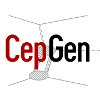Processes list#
Natively, CepGen provides a collection of predefined, historical processes that can be extended or modified by the user. This page lists and describes them.
As derivatives of a base cepgen::proc::Process object, a few common members and steering parameters are characterising all processes.
For instance, in the description of all process parameters, one may notice the following parameters are systematically steered from the user:
alphaEM(cepgen::ParametersList): one of the interpolation modules for thealphaS(cepgen::ParametersList): one of the interpolation modules for thehasEvent(bool): does the process also define an event content that can be generated?kinematics(cepgen::ParametersList): the definition of the phase space to be integrated and for which events will be generated. It is defined in the subsection below ;randomGenerator(cepgen::ParametersList): the modelling for a (potential) random number generator to be used by the process.
Note
List of user-steerable parameters for the definition of event kinematics
Click to show
The kinematics parameters block contains the usual parameters to be steered:
formFactors(2-component vector of cepgen::ParametersList, for positive-z and negative-z beams respectively): one of the electromagnetic/DIS beam form factors modellings (see the list)structureFunctions(cepgen::ParametersList): one of the inelastic beam structure functions modellings (see the list)mode(integer): kinematic regime to generate and the size of the phase space to perform the integration. It can take the following values:ProcessMode.ElasticElastic: elastic emission of photons from the incoming protons (default value if unspecified),
ProcessMode.ElasticInelastic and ProcessMode.InelasticElastic: elastic scattering of one photon and an inelastic/semi-exclusive emission of the other photon, resulting in the excitation/fragmentation of the outgoing proton state,
ProcessMode.InelasticInelastic: both protons fragmented in the final state.
Kinematic cuts are characterised by three parameters collections to be steered:
central(cepgen::ParametersList) for central particles cutsinitial(cepgen::ParametersList) for initial partons/beam particles cutsremnants(cepgen::ParametersList) for beam particles remnants (after the hard interaction)
Additionally, a few parameters are steered to define the beams and their kinematics:
pdgIds(vector<int>) for the specification of positive-z and negative-z beam PDG, or HI identifiers. For historical/backward-compatibility reasons, one may also use the following parameters:beam1idandbeam2idfor the PDG identifier of positive-z and negative-z (resp.) incoming beamsbeam1A/beam1Z, andbeam2A/beam2Zmay be used for the atomic/mass numbers of HI beams
energies(vector<double>) for the specification of positive-z and negative-z beam energies (in GeV)pz(vector<double>) for the specification of positive-z and negative-z longitudinal beam momenta (in GeV/c)
In the case of symmetric beam particles, the sqrtS (double) parameter may also be used to directly specify the two-beam centre-of-mass energy (in GeV).
LPAIR’s
The LPAIR .
In CepGen, it can be reached through the lpair process.
It allows to compute the cross-section and generate events for the
A phenomenological review of both this process and its first implementation in LPAIR may be found in .
The object is implemented as LPAIR, and a list of process-specific steering parameters can be found here.
Factorised processes#
This page describes the different techniques used to simplify the computation of a central exclusive process through the factorisation of its total matrix element into sub-blocks:
a parton-from-beam particle flux, encompassing all kinematic features of a “physical” emission, possibly leaving the beam particle on-shell (i.e. surviving the emission), or in a diffractive state (possibly dissociating into a hadronic jet) ;
a parton-parton matrix element, e.g. a
CepGen gives the user a relative freedom in its implementation of factorised, two-parton level processes. As of version 1.2.0, two main parton emission types (and central matrix element definitions) are indeed handled:
a standard, collinear parton emission, with a
a parton
To be considered as a valid factorised process implementation in CepGen, the user class is required to derivate from a cepgen::proc::FactorisedProcess base class, with a few required user-overriden methods. See this page for a detailed description of these methods.
Collinear parton emission#
Warning
Under construction
The BeamRemnants:primordialKT flag).
For instance, a
where
Elastic unintegrated photon densities are expressed as functions of the proton electric and magnetic form factors
The inelastic contribution further requires both the diffractive state four-momentum norm
with
Implementations#
The photon transverse momentum-dependant description of this process was previously developed in PPtoLL, and described in .
Since it now also supports the quark-antiquark production (thus all charged fermions), it is defined as the PPtoFF process in CepGen.
Process-specific options#
method(integer): switch between the two matrix element definitions:0: on-shell amplitude,1: off-shell amplitude.
pair(integer/PDG): PDG identifier of the fermion pair to be produced in the final state. It can take the following values:PDG.electron := 11:PDG.muon := 13:PDG.tau := 15:PDG.down,PDG.up,PDG.strange,PDG.charm,PDG.bottom,PDG.top(or equivalently1-6): quark pair production.
Full object reference#
Warning
doxygenclass: Cannot find class “PPtoFF” in doxygen xml output for project “CepGen” from directory: /Documentation/build/xml
The two-photon production of gauge boson pairs process, i.e.
Process-specific options#
method(integer): switch between the two matrix element definitions:0: on-shell amplitude ,1: off-shell amplitude .
polarisationStates(int): switch between all combinations of polarisation states to be included in the matrix element. It can take the following values:0: all contributions,1: longitudinal-longitudinal,2: longitudinal-transverse,3: transverse-longitudinal,4: transverse-transverse.
Full object reference#
Warning
doxygenclass: Cannot find class “PPtoWW” in doxygen xml output for project “CepGen” from directory: /Documentation/build/xml
